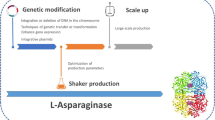Abstract
Putrescine finds wide industrial applications in the synthesis of polymers, pharmaceuticals, agrochemicals, and surfactants. Owing to economic and environmental concerns, the microbial production of putrescine has attracted a great deal of attention, and ornithine decarboxylase (ODC) is known to be a key enzyme in the biosynthetic pathway. Herein, we present the design of ODC from Escherichia coli with high catalytic efficiency using a structure-based rational approach. Through a substrate docking into the model structure of the enzyme, we first selected residues that might lead to an increase in catalytic activity. Of the selected residues that are located in the α-helix and the loops constituting the substrate entry site, a mutational analysis of the single mutants identified two key residues, I163 and E165. A combination of two single mutations resulted in a 62.5-fold increase in the catalytic efficiency when compared with the wild-type enzyme. Molecular dynamics simulations of the best mutant revealed that the substrate entry site becomes more flexible through mutations, while stabilizing the formation of the dimeric interface of the enzyme. Our approach can be applied to the design of other decarboxylases with high catalytic efficiency for the production of various chemicals through bio-based processes.




Similar content being viewed by others
References
Adkins J, Pugh S, McKenna R, Nielsen DR (2012) Engineering microbial chemical factories to produce renewable “biomonomers”. Front Microbiol 3:313
Altschul SF, Gish W, Miller W, Myers EW, Lipman DJ (1990) Basic local alignment search tool. J Mol Biol 215(3):403–410
Becker J, Wittmann C (2012) Bio-based production of chemicals, materials and fuels—Corynebacterium glutamicum as versatile cell factory. Curr Opin Biotechnol 23(4):631–640
Eppelmann K, Nossin P, Raeven L, Kremer S, Wubbolts M (2006) Biochemical synthesis of 1, 4-butanediamine. WO2006005603
Eswar N, Webb B, Marti-Renom MA, Madhusudhan M, Eramian D, Shen My, Pieper U, Sali A (2006) Comparative protein structure modeling using MODELLER. Curr Protoc Bioinformatics 5.6. 1–5.6. 30
Henikoff S, Henikoff JG (1992) Amino acid substitution matrices from protein blocks. Proc Natl Acad Sci U S A 89(22):10915–10919
Hess B, Kutzner C, Van Der Spoel D, Lindahl E (2008) GROMACS 4: algorithms for highly efficient, load-balanced, and scalable molecular simulation. J Chem Theory Comput 4(3):435–447
Jackson LK, Baldwin J, Akella R, Goldsmith EJ, Phillips MA (2004) Multiple active site conformations revealed by distant site mutation in ornithine decarboxylase. Biochemistry 43(41):12990–12999
Kanjee U, Gutsche I, Ramachandran S, Houry WA (2011) The enzymatic activities of the Escherichia coli basic aliphatic amino acid decarboxylases exhibit a pH zone of inhibition. Biochemistry 50(43):9388–9398
Kind S, Wittmann C (2011) Bio-based production of the platform chemical 1,5-diaminopentane. Appl Microbiol Biotechnol 91(5):1287–1296
Lee JW, Kim HU, Choi S, Yi J, Lee SY (2011) Microbial production of building block chemicals and polymers. Curr Opin Biotechnol 22(6):758–767
Li H, Cao Y (2010) Lactic acid bacterial cell factories for gamma-aminobutyric acid. Amino Acids 39(5):1107–1116
Momany C, Ernst S, Ghosh R, Chang NL, Hackert ML (1995) Crystallographic structure of a PLP-dependent ornithine decarboxylase from Lactobacillus 30a to 3.0 A resolution. J Mol Biol 252(5):643–655
Myers DP, Jackson LK, Ipe VG, Murphy GE, Phillips MA (2001) Long-range interactions in the dimer interface of ornithine decarboxylase are important for enzyme function. Biochemistry 40(44):13230–13236
Nagashima Y, Kako K, Kim J-D, Fukamizu A (2012) Enhanced histamine production through the induction of histidine decarboxylase expression by phorbol ester in Jurkat cells. Mol Med Rep 6(5):944–948
Offman MN, Krol M, Patel N, Krishnan S, Liu J, Saha V, Bates PA (2011) Rational engineering of L-asparaginase reveals importance of dual activity for cancer cell toxicity. Blood 117(5):1614–1621
Okoniewska M, Tanaka T, Yada RY (1999) The role of the flap residue, threonine 77, in the activation and catalytic activity of pepsin A. Protein Eng 12(1):55–61
Oliveira EF, Cerqueira NM, Fernandes PA, Ramos MJ (2011) Mechanism of formation of the internal aldimine in pyridoxal 5′-phosphate-dependent enzymes. J Am Chem Soc 133(39):15496–15505
Qian ZG, Xia XX, Lee SY (2009) Metabolic engineering of Escherichia coli for the production of putrescine: a four carbon diamine. Biotechnol Bioeng 104(4):651–662
Romano A, Trip H, Lolkema JS, Lucas PM (2013) Three-component lysine/ornithine decarboxylation system in Lactobacillus saerimneri 30a. J Bacteriol 195(6):1249–1254
Schmid N, Eichenberger AP, Choutko A, Riniker S, Winger M, Mark AE, van Gunsteren WF (2011) Definition and testing of the GROMOS force-field versions 54A7 and 54B7. Eur Biophys J 40(7):843–856
Schneider J, Wendisch VF (2010) Putrescine production by engineered Corynebacterium glutamicum. Appl Microbiol Biotechnol 88(4):859–868
Scott E, Peter F, Sanders J (2007) Biomass in the manufacture of industrial products—the use of proteins and amino acids. Appl Microbiol Biotechnol 75(4):751–762
Vickers CE, Blank LM, Kromer JO (2010) Grand challenge commentary: chassis cells for industrial biochemical production. Nat Chem Biol 6(12):875–877
Vienozinskiene J, Januseviciute R, Pauliukonis A, Kazlauskas D (1985) Lysine decarboxylase assay by the pH-stat method. Anal Biochem 146(1):180–183
Yamanobe T, Kurihara Y, Uehara H, Komoto T (2007) Structure and characterization of nylon 46. J Mol Struct 829(1):80–87
Author information
Authors and Affiliations
Corresponding author
Electronic supplementary material
Below is the link to the electronic supplementary material.
ESM 1
(PDF 286 kb)
Rights and permissions
About this article
Cite this article
Choi, H., Kyeong, HH., Choi, J. et al. Rational design of ornithine decarboxylase with high catalytic activity for the production of putrescine. Appl Microbiol Biotechnol 98, 7483–7490 (2014). https://doi.org/10.1007/s00253-014-5669-8
Received:
Revised:
Accepted:
Published:
Issue Date:
DOI: https://doi.org/10.1007/s00253-014-5669-8




